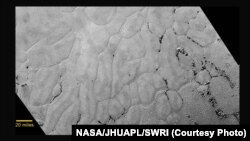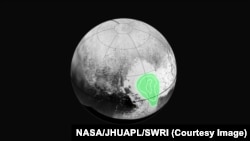U.S. Space Agency NASA released more photos of the surface of Pluto showing smooth, frozen plains, following the first spacecraft flyby of the distant dwarf planet.
Close-up photographs of the vast plains were released Friday, several days after the first set of pictures from the New Horizons mission revealed a range of icy mountains as high as 3,500 meters above Pluto's surface.
Scientists said the mountains and plains were likely formed no more than 100 million years ago, a relatively short time in the solar system's 4.56 billion-year history.
They speculated at a news conference at Cape Canaveral, Florida, Friday that Pluto is still being shaped by active geological processes.
"This terrain is not easy to explain," said Jeff Moore, the head of the New Horizons geology team at NASA's Ames Research Center in California.
Moore said scientists are still in the most preliminarily stages of the investigations into Pluto's surface.
Only about 1 percent of the 50 gigabytes of data recorded in the close encounter with Pluto has been relayed back to Earth.
The nuclear powered New Horizons – moving faster than any spacecraft ever built at a speed of more than 49,500 kilometers per hour – sped by Pluto Tuesday, getting as close as 12,500 kilometers and grabbing a huge volume of data.
Especially astounding to scientists was the absence of craters on Pluto. They said that suggests to their surprise that Pluto is geologically active even now, and is being sculpted not by outside forces but by internal heat.
The New Horizons team announced this week it was naming the "heart" shape on Pluto's surface, Tombaugh Regio, after Clyde Tombaugh, the discoverer of Pluto.
The mission completes the exploration of the solar system, and it makes the United States the first nation to send a space probe to every planet from Mercury to Pluto.
WATCH: Related video on Pluto













